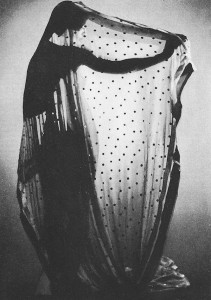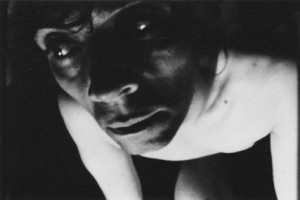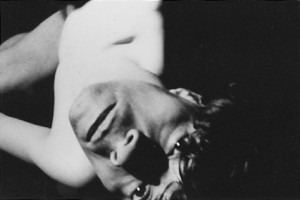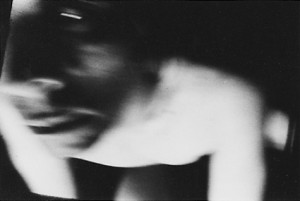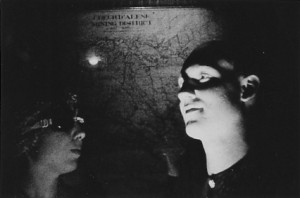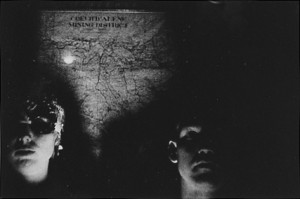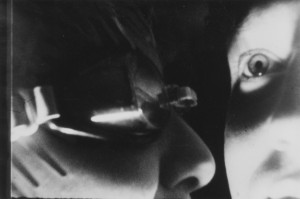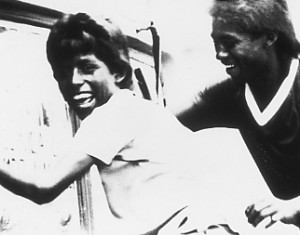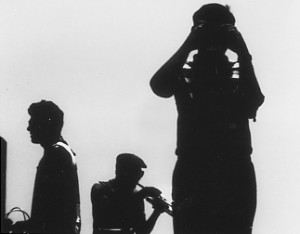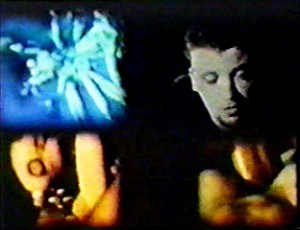
Originally published in MESH (Journal of Modern Image Makers Association, St. Kilda, Victoria, Australia), Spring 1994.
For the past decade and a half Mike Hoolboom has taken the body as his subject, and offered a fascinating glimpse at the intersection of flesh and machine. If outrage and transgression have been his hallmarks, these have been graced with a careful attention to the materials of cinema itself. Here are bodies exposed at the limits of representation, the protuberances of organs and bone wrapped in cinema’s second skin, our own flesh the product of an assembly line manufacture. His work may be divided into three periods of production – the first narrating an encounter with the materials of cinema, the second deploying these materials towards a diary practice, and the third describing the shattered compact between body and machine after the filmmaker discovered he was HIV-positive.
Hoolboom’s first period is marked by a materialist practice which interrogates the limits of the cinematic medium. Individual aspects of the medium are selectively excised and examined in a formalist’s catalogue which imagines that our tools of perception shape our experience, that our bodies have been engaged in a machine-inspired elaboration – feet have become cars, eyes become telescopes, hands become bulldozers. These mechanical prostheses are not without ideology or syntax, the rules of their deployment actively reframing the subject that seeks to use them.
That cinema is comprised of a succession of still photographs is detailed in Book of Lies (1985), in which an airline commercial is extended by placing decreasing amounts of dark between each frame. The film’s subject is a male climber whose cropped attitudes of traversal are re-examined in the frame by frame scaling of a mountain. Upon reaching the summit he prepares to dive headlong into the waters below, the dark passage between the frames narrowing, until sound and image merge at the instant of his plunge into the water. Here, the body displays itself as an attitude of parts, broken by a machine-made compact of representation, its gestures of ascent subject to a narrative gaze of tumescent arousal and deflation (emblematized by the climber’s rise and fall), and viewed as an accumulation of fragments.
Scaling (1988) remarks the aspect ratio of 16mm cinema as Hoolboom paints black the space of the frame. Once again, the rules of the machine are pitted against its human protagonist. Hoolboom is naked throughout, the camera tipped on its side to underscore a gravity bent to the rule of representation, the body made to accommodate the camera’s rectangular vision, outlining the arena of encounter. This image is run twice simultaneously, printed backwards and forwards to show the filmmaking painting the rectangle black on one side of the frame, while he unpaints the other side. This doubling of intentions ensures that action and unaction arrive together, he patiently undoes all that he does.
Modern Times (1991) is an essay on the motion picture camera, miming its subject to assume its own shape. Framed by passages of black leader, the film appears as a black box, while illuminated interiors draft a harrowing image of industrial consciousness. As a film camera is wound, images of Chaplin from Modern Times intercede, the little tramp tightening screws on the assembly line. Soon enough he is swept into the line and pushed through a passage of cogs and wheels that bear an unmistakable resemblance to the film path of a camera. The remainder of the film shows a male nude rendered in a frantic and broken montage, his body reduced to a flailing maelstrom of parts. The understanding that the camera imparts to the body is literalised here, its movements shattered in the gaze that doubles it.
Hoolboom’s diary practice takes up the issue of the body from another vantage, elaborating a paternal home movie practice and deploying it towards a critique of patriarchy. In Was (1989), he punctuates images of a marital dissolution with a hallucinatory Ford commercial. As the potential buyer looks at the car of her future, she glimpses, matted into its interiors, a number of fantasies. She wins a beauty contest, has a Parisian idyll with two men, another man offers her flowers and, finally, she sees her own marriage. That these fantasies are male-inspired and projected onto women is further underlined in the film’s longest montage sequence. As we watch images of Hoolboom and his partner talk, quarrel and make love, a women’s voice recounts a dream of patriarchy from Italo Calvino’s Invisible Citie s. In this story, she flees naked through a city while a number of men chase her. While she manages to elude them, the sites of her escape are marked by each of her pursuers as they build lodgings and walls for themselves. Altogether, this city comprises an ugly architecture of containment and repression, its masculine imperatives designed to frustrate the Other. At once an auto-critique of the film he laboriously constructs, and an indictment of a masculinist longing for mastery and control, Was ‘s fragmented bodies demonstrate the effects of a rationalist will-to-power, the body refigured through the crucible of representation.
In Eat (1989), Hoolboom returns to these diary images and escalates the ferocious montage, dissecting the gestures of the everyday into two and three frame passages, shattering the bodily compact of these two lovers. Into their broken flesh he pours the pop effluvia of TV commercials and beauty contests, pornography, rotoscoped passages, titles from Dante’s Inferno and a wash of landscape imagery. These are combined in six picture rolls which are overlaid via printing and then played twice, firstly while a woman recounts her anorexia, and a second time as a man recalls a friend who ate himself to death. In both Eat and Was , the body is ravaged, torn apart through montage, its perimeters shattered to admit the capitalist issue of its televisual landscape. In both instances, this order is rendered as a masculine preserve, its accelerating codes of containment signified by a spectacle and death on the one hand, and in a lover’s body viewed as part of an object universe on the other. The grammars of intimacy are recast as an industrial concern, a combination of mass production and a lost subjectivity, our technical prosthesis relearned as a model for love.
This diary work was coincident with the discovery by the filmmaker that he was HIV-positive. These images of a body rent and ruptured are images of the disease itself, madly proliferating in a body doomed to collapse. Hoolboom’s response has been typically expansive and diverse. Since 1989 he has produced no fewer than three films per year, and as many a six. This acceleration of production includes five films made in collaboration with other filmmakers, a rarity in the artisanally-based productions of the avant garde. His AIDS work features an assured cine-rhetoric learned in a decade of materialist manufacture, and a practice haunted by death and the dissolution of the body. While only a few of these films explicitly denote the subject of AIDS, it remains an overwhelming subtext for all of this work, as Hoolboom continues to examine the body and its relation to power, identity and death.
Careful Breaking (1992) was one of a half dozen films finished in 1992. Hypnagogically colourised, it is set to a great, discordant soundtrack of shattered glass by composer Earle Peach. Careful Breaking narrates a body recalling itself, conjuring in its saturated palette a history of flesh. Here is a body traveling its own perimeter in a rapidly flashing montage of light and dark, which gives way at the film’s end to a recoloured male nude, rendered initially as a body of parts via frame-by-frame photography, and then lying in repose. The film closes with a fist unclenching, releasing the fiction of the body’s wholeness and reconciling itself as a compact of fragments.
One Plus One (1993) is a pixilated romp featuring co-filmmakers Jason Boughton and Kathryn Ramey. Photographed one frame at a time over three days, One Plus One casts Boughton and Ramey as unlikely lovers, the first appearing as a hovering devil in flight, excreting a vegetable life, while Ramey’s clock-spitting, bathing-besuited self enclosure lifts weights with frank indifference to his approaches. Their touch promotes a shimmering aura of light which they fight against, finally retiring to the kitchen with an armful of tools where they attempt to fine tune desire. Donning each other’s clothes, they fly off together to the strain of Strauss’s Blue Danube Waltz . This wordless repast is played out on the body’s surface, its movements of opening and closing retooled to accommodate another.
Mexico (1992) is another collaboration, this time with friend and fellow Canadian filmmaker Steve Sanguedolce. An episodic travelogue haunted by death, Mexico unfolds like a series of postcards, accompanied by a voice-over address which insistently converts Mexico into Toronto. Half the film is lensed in Toronto, though the voice-over insists that ‘you’ are seeing Mexico. The movie narrates the travels of ‘you,’ an individual unable to leave her/his past, or geography, behind. “Behind the wheel you are like King Midas, everything you touch turns into Toronto.” Later, a hilarious montage of B-movie monsters wreak havoc in city streets while the narrator muses, “You watch with surprise as giant lizards walk the street again, wondering that these discarded pictures should have found a new life here in Mexico. After all these years, what were they seeing exactly? What secret horror lies waiting beneath the face of these monsters, slouching towards Mexico City, to be born?” This ‘secret horror’ is precisely the visitation of first worlders, and the recently negotiated free trade pact between Mexico, the US and Canada, part of a global pact of homogenizing difference and ensuring economic servitude. If the automobile provides one of Mexico ‘s many leitmotifs, it serves primarily as a symbol of colonialism. As the narrator describes, looking at the lines on the highway, “If these lines are illegible, perhaps it is because they were made by people who failed to understand that the automobile was less a method of travel than a way of life. That these lines were a chronicle of change, bonding the country with a life beyond its borders, marrying its unfinished geographies with the auto factories of the north.” While the judo teams of Monterey, dinosaurs and aquariums, war museums and jungle factories, float past, the travellers’s escape is equated with death, his restless traversals staging a return of the repressed. The film is capped by a vicious amateur bullfight in Mexico City, a clumsy, bloody affair which sees the matador trampled and gored before killing the bull in an agonizingly protracted death scene. Gone here is the glamour and seduction of spectacle, underlined by the scene’s binocular matte. In its place stands the cold slaughter of the first worlder, seeking his dissolution in foreign cities, but re-fashioning in place of his destination the place of his origin, which, for this tourist, is an endgame of displacement.
Frank’s Cock (1993) remains Hoolboom’s most explicit AIDS narrative. Centered around a first person confessional, actor Callum Rennie narrates the saga of ‘Frank,’ his former mentor, lover and confidant. He describes the difficulties of growing up gay: his introduction into gay life (“I wanted to be the Michael Jordan of sex. Wayne Gretzky with a hard-on”); being Canadian (“a Canadian is someone who can open a beer with anything”); sex (I never had anyone lick my ass before, I know I’m going to sound sentimental, but, everyone’s got their own way to worship”) and, of course, Frank’s cock (“I know that size isn’t everything, but it just seemed to fit, you know?”). Frank finally succumbs to AIDS and dies, leaving his lover to tell his story. While Rennie recites his tale of lust and mourning directly into the camera, the screen splinters into four equal parts, each displaying a different bodily attitude. Rennie talks throughout on screen right, while beside him unfold abstract images photographed inside the body. Below Rennie this a cropped version of Madonna’s Erotica video flickers past. The fourth screen shows close-ups of gay pornography. This four-sided mosaic is a frank evocation of the effects of AIDS, the body broken into dispersed vantages as the narrator attempts to bind with words what this disease threatens.
With 17 million people worldwide diagnosed with HIV, Hoolboom is scarcely alone in his condition. But he has used his privilege as a first-world artist to offer testimony from the front, his film practice part of a burgeoning discourse by those who are infected. In this university of death we are learning a new grammar of morality, a lexicon of illness and decline, and, finally, for each of us, an understanding of how to die.
